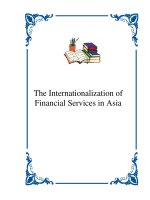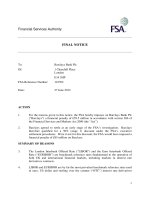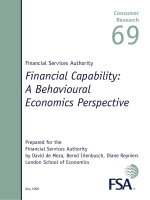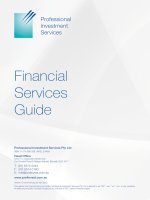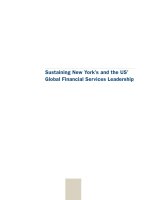Financial Services
Bạn đang xem bản rút gọn của tài liệu. Xem và tải ngay bản đầy đủ của tài liệu tại đây (519.67 KB, 34 trang )
•
•
•
•
•
•
•
Activity 1………….Why Do You Need A Bank?
Activity 2………The Many Services of a Bank
Activity 3….The ABCs of a Checking Account
Activity 4……….Opening a Checking Account
Activity 5………………….How to Write a Check
Activity 6…..Maintaining a Checking Account
Activity 7……The ABCs of a Savings Account
ACTIVITY 1
Why Do You
Need a Bank?
Overview
• Purposes of banks
• The differences between banks and
credit unions
• Safety of financial institutions
• Banks as money management tools
• The Earned Income Tax Credit
2
Basic Banking Services - Activity 1
SAFETY OF FINANCIAL INSTITUTIONS
COMMERCIAL BANKS
3
CREDIT UNIONS
Slide 1 – Safety of Financial Institutions
Lesson Reference: Basic Banking Services, Activity 1 – Overhead 3
THE EARNED INCOME TAX CREDIT
The Earned Income Tax Credit (EITC) is a federal income tax credit for lowincome workers. The credit reduces the amount of tax an individual owes,
and may be returned to the taxpayer in the form of a refund. Some states
offer additional forms of EITC.
Eligible workers must have an annual income and investment income that
falls below a certain level. In tax year 2005, for example, if you are married,
have two or more children, and are filing your taxes jointly, your combined
annual income must not exceed $37,263. You must have a Social Security
Number to receive the EITC.
In tax year 2005, a family with two or more children could receive up to a
$4,400 refund through the EITC.*
4
Slide 2 – EITC
Lesson Reference: Basic Banking Services, Activity 1 – Handout 2
ACTIVITY 2
The Many Services
of a Bank
Overview
•
•
•
•
5
Financial services provided by a bank
Bank employees
Services that might be of personal benefit
The impact of state and federal regulations
upon the security of a bank
Basic Banking Services - Activity 2
REMITTANCE OPTIONS
TO SEND AND RECEIVE MONEY
1.
2.
3.
4.
5.
6.
7.
6
Money Transfer Organizations
Bank Transfers
Hand Delivery
Hawala
Post Offices
Stored Value Cards
Slide 1 – Remittance Options
Lesson Reference: Basic Banking Services, Activity 2 - Overhead 1
BANK OCCUPATIONS
•
•
•
•
•
7
Tellers
Platform Bankers
Mortgage Lenders
Operations Manager
Branch Manager
Slide 2 – Bank Occupations
Lesson Reference: Basic Banking Services, Activity 2 – Overhead 2
ELECTRONIC BANK SERVICES
Online banking is the fastest growing Internet
activity in the U.S.
Types of Services
• Bank Cards
• Automated Services
Protect Your Passwords!
8
Slide 3 - Electronic Bank Services
Lesson Reference: Basic Banking Services, Activity 2 – Overhead 3
BANK CARD TYPES
9
TYPE
• Check Cards or
ATM/Debit Cards
DESCRIPTION
•
• Bank cards with preset, limited value.
• Used to pay for goods and services.
• Alternative to cash.
• Bank cards that allow for the payment
of goods and services to be subtracted
directly from a bank deposit account.
• Can be used with merchants that take
major credit cards—known as point of
sale (POS) transactions.
Slide 4 - Bank Card Types
Lesson Reference: Basic Banking Services, Activity 2 – Overhead 4
ELECTRONIC BANK SERVICES
•
•
•
•
•
•
10
Direct Deposit
Transfers between Accounts
Transfers to a Third Party
Online Banking
Bank by Phone
ATM
Slide 5 – Electronic Bank Services
Lesson Reference: Basic Banking Services, Activity 2 – Handout 3
REGULATION OF ELECTRONIC
BANKING SERVICES
Electronic Fund Transfer Act
Protects consumers using any type of electronic
banking from loss and protects their privacy.
Banks must:
• Offer consumers a record or receipt for all computer
transactions.
• Investigate errors and report to consumer within ten days
of error notification.
Customers are responsible to report any errors.
11
Slide 6 - Regulation of Electronic Banking
Lesson Reference: Basic Banking Services, Activity 2 – Overhead 5
ACTIVITY 3
The ABCs of a
Checking Account
Overview
• Purposes of a checking account
• Shopping for and comparing checking accounts
12
Basic Banking Services - Activity 3
CHECKING ACCOUNT TERMS
• Bank Statement
• Cancelled Check
• Check
• Check Register/Ledger
• Endorsement
• Fee
• Interest
• Minimum Balance
13
• Outstanding
Transactions
• Overdraft
• Overdraft Protection
• Payee
• Reconciling a Bank
Statement
• Transaction Limits
Slide 1 - Checking Account Terms
Lesson Reference: Basic Banking Services, Activity 3 – Handout 1
SHOPPING
AROUND
(THINGS TO
ASK ABOUT
WHEN
OPENING A
CHECKING
ACCOUNT)
14
SERVICES
Location of bank
Location of ATMs
Banking hours
Minimum balance required
Minimum transactions or limits
Interest-bearing accounts?
Other
COSTS
Non-primary bank ATM transactions
In-branch transaction fees
Per-check fees
Other checking fees
Overdraft protection
Printing of checks
Slide 2 - Shopping Around
Lesson Reference: Basic Banking Services, Activity 3 - Handout 2
ACTIVITY 4
Opening a Checking
Account
Overview
•
•
•
•
•
15
Checking Account Application Process
The Application
Acceptable Forms of ID
The Signature Authorization Card
The PATRIOT Act
Basic Banking Services - Activity 4
OPENING A CHECKING ACCOUNT
16
Slide 1 – Opening a Checking Account
Lesson Reference: Basic Banking Services, Activity 4 – Handout 1
COMMONLY ACCEPTED FORMS OF ID
Primary ID*
• Photo Driver’s License issued
within the U.S. or Canada
• State Non-Driver Photo ID
• Photo Learner’s Permit
• Government Photo ID
• U.S. Passport
• Non-U.S. Passport
• Resident Registration Card
• Naturalization Certificate
• Employee Photo ID
(from a recognizable employer)
• Photo Trade License
(barber, plumber, electrician, etc.)
• Student Photo ID
(college/trade school)
• Medicare Card
(must be 65 or older)
• Mexican Consular ID
(Matricula Consular)
* Financial institutions' ID requirements may differ; check with the institution first before
applying for an account.
17
Slide 2 - Commonly Accepted Forms of ID
Lesson Reference: Basic Banking Services, Activity 4 – Handout 2
COMMONLY ACCEPTED FORMS OF ID
Secondary ID*
• Foreign Driver’s License
• Pay Stub
• State/Local Gun Permit
• Car Registration
• Utility Bill (Name and address
of individual account should
be listed)
• Mortgage Statement
• Current Bank Statement
• Letter of Introduction from Bank,
Embassy, or well-known
Employer
• National Credit Card
• Welfare Card
• Bank-issued Debit or Check Card
• Supplemental Health
Insurance Card
* Financial institutions' ID requirements may differ; check with the institution first before
applying for an account.
18
Slide 3 - Commonly Accepted Forms of ID
Lesson Reference: Basic Banking Services, Activity 4 – Handout 2
THE PATRIOT ACT
Congress passed the PATRIOT Act in response to the terrorist
attacks of September 11, 2001. Financial institutions are now
required to collect certain information when a new account is
opened.
1.
The customer must provide identification that includes
name, date of birth, address, and identification number.
2. The institution must maintain a copy of the information used
to verify the person’s identity.
3. The institution must determine whether the applicant
appears on the lists of known or suspected terrorists or
terrorist organizations.
19
Slide 4 – The PATRIOT Act
Lesson Reference: Basic Banking Services, Activity 4 – Overhead 1
SIGNATURE AUTHORIZATION CARD
20
Slide 5 – Signature Authorization Card
Lesson Reference: Basic Banking Services, Activity 4 – Handout 3
ACTIVITY 5
How to Write a Check
21
Basic Banking Services - Activity 5
WRITING A CHECK
22
Slide 1 - Writing a Check
Lesson Reference: Basic Banking Services, Activity 5 – Handout 1
ACTIVITY 6
Maintaining a
Checking Account
Overview
•
•
•
•
•
•
23
Check 21
Keeping a check register
Making a deposit into a checking account
Reconciling a bank statement
Maintaining a checking account
Avoiding Overdrafts
Basic Banking Services - Activity 6
CHECK 21
Check 21 is a federal law that helps banks handle
more checks electronically and that makes check
processing faster and more efficient.
Under this law, a check deposited in a bank is
typically “delivered” overnight to the paying bank and
deducted from the checkwriter’s account on the next
business day.
Money may be deducted from your checking account
almost immediately.
24
Slide 1 – Check 21
Lesson Reference: Basic Banking Services, Activity 6 – Handout 1
KEEPING A CHECK REGISTER
25
Slide 2 - Keeping a Check Register
Lesson Reference: Basic Banking Services, Activity 6 – Handout 2



